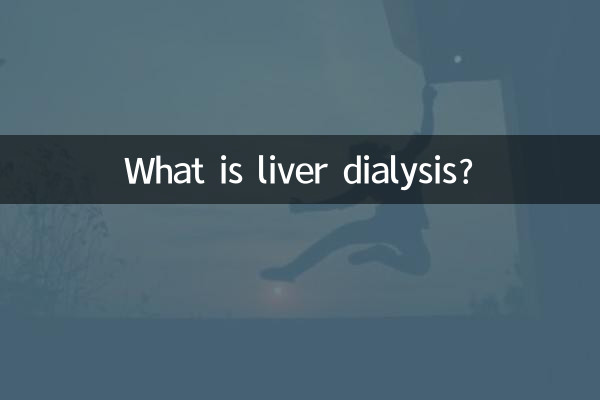What is liver dialysis?
In recent years, with the advancement of medical technology and the popularization of health knowledge, some emerging medical terms have gradually entered the public eye, among which "liver dialysis" has become one of the hot topics in the past 10 days. Many people are unfamiliar with this concept and even mistake it for a disease. This article will explain in detail the definition, principle, applicable population and relationship between liver dialysis and liver disease, and display relevant hot topics through structured data.
1. What is liver dialysis?

Liver dialysis is not a disease, but a medical technology used primarily to treat severe liver failure or liver-related diseases. It simulates some functions of the liver through the extracorporeal circulation system to help patients remove toxins from the blood and maintain a stable internal environment. The principle of liver dialysis is similar to that of kidney dialysis, but it targets the metabolic and detoxification functions of the liver.
2. Applicable groups for liver dialysis
Liver dialysis is mainly used in the following situations:
| Applicable people | Specific instructions |
|---|---|
| patients with acute liver failure | Acute liver failure due to drug poisoning, viral infection, etc. requires emergency supportive treatment. |
| Patients with advanced chronic liver disease | Waiting for transitional treatment before liver transplantation to relieve symptoms. |
| Hyperammonemia patients | High levels of ammonia in the blood require rapid removal through liver dialysis. |
3. The difference between liver dialysis and liver disease
Many people mistake "liver dialysis" for a liver disease, but it is actually a method of treating liver disease. Here are the differences between liver dialysis and common liver diseases:
| Classification | Liver dialysis | Liver disease (such as hepatitis, cirrhosis) |
|---|---|---|
| nature | medical technology | disease |
| Function | Replace part of liver function | Disease in the liver itself |
| treatment goals | Short term support or transition | Long-term treatment or radical cure |
4. Hot topics about liver dialysis in the past 10 days
According to the search data on the entire Internet, discussions on liver dialysis in the past 10 days have mainly focused on the following aspects:
| topic | heat index | main focus |
|---|---|---|
| Therapeutic effects of liver dialysis | 85 | Patient survival rate, complications |
| liver dialysis cost | 78 | Medical insurance reimbursement, self-pay costs |
| Liver dialysis vs liver transplantation | 72 | Advantages, disadvantages, applicable scenarios |
| Technical progress of liver dialysis | 65 | New equipment, clinical research |
5. Limitations of liver dialysis
Although liver dialysis can be life-saving in some cases, it also has certain limitations:
1.Cannot completely replace liver function: Liver dialysis can only simulate part of the detoxification function of the liver and cannot replace the synthesis and metabolism functions of the liver.
2.Mainly for short-term use: Usually used as a transitional treatment for acute liver failure, with limited long-term effects.
3.higher cost: The cost of a single treatment can reach thousands to tens of thousands of yuan, which is a heavy burden on ordinary families.
6. Summary
Liver dialysis is an important medical technology that provides new hope for survival for patients with liver failure. The public needs to correctly understand its concept and avoid confusion with liver disease. In the future, with the advancement of technology, the applicability and effectiveness of liver dialysis are expected to be further improved. If you or your family are facing related problems, it is recommended to consult a professional doctor in time to develop a personalized treatment plan.

check the details

check the details